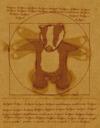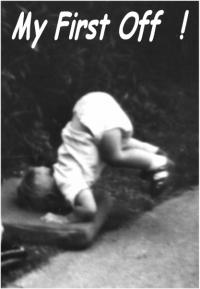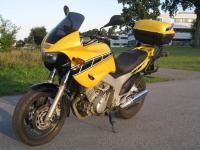Thanks to Facebook keep changing the way they host photos the bloody links keep breaking, photos should work on this link if they don't show up in the post below
https://www.facebook...=3&l=4d458f092a
Someone (Studley?) asked me to post up some notes on doing valve clearances when I got round to checking them. This is on a Mk1 but once the tanks off I’d expect most of it to be the same for a Mk2. Where I say left/right or front/back I mean from the point of view of you sat on the bike. I started with the bike on a paddock stand, as I find it easier if it’s vertical rather than leaning on the sidestand.
First off, get the faring off (you could probably leave the nose cone on but removing it gives more space at the sides to get the radiator off), then fuel tank. For the tank close the tap, remove the 2 bolts from the tap, then take off the bottom pipe off the tap, be aware this will dribble some fuel out so have a rag handy.
 4713_92444176011_8183372_n.jpg 68.42KB
15 downloads
4713_92444176011_8183372_n.jpg 68.42KB
15 downloads
One bolt at the back of the tank, and a bolt in to the frame on either side, and the tank will lift up enough to allow you disconnect the breather on the back left, and feed the fuel tap up clear of the frame, before lifting the tank off.
Airbox off next, with a screw at the front, 2 clamps on the rubbers, and the crank case breather seen here between the rubbers. As you lift it up you’ll find another breather on the left hand side
 4713_92444186011_3283944_n.jpg 56.55KB
13 downloads
4713_92444186011_3283944_n.jpg 56.55KB
13 downloads
With the bash plate off (2 bolts underneath and the long pin) you can undo the coolant drain bolt, you’ll need to take the radiator cap off before anything comes out though.
 4713_92444191011_2822803_n.jpg 66.13KB
7 downloads
4713_92444191011_2822803_n.jpg 66.13KB
7 downloads
Next it’s the radiator. I find it easiest to disconnect the right hand pipe at the bottom where it attaches to the water pump, and to take the left hand pipe off the radiator. Disconnect the power from the fan (black connector somewhere under where the airbox was) and don’t forget the overflow pipe just below the radiator cap. With a bit of newspaper to protect the front mudguard I find I can undo the 4 bolts that hold the radiator frame to the bike and just about wiggle it free, less hassle than taking the radiator off the frame
 4713_92444196011_8131812_n.jpg 60.55KB
4 downloads
4713_92444196011_8131812_n.jpg 60.55KB
4 downloads
There are 3 electrical connections on the top of the thermostat; a 2 pin connector, a push fit for the sender, and screw and spade that I guess is probably an earth. With them all disconnected remove the hose from the pipe that sticks out of the valve cover, then there’s just 1 bolt holding the thermostat to the frame.
 4713_92444201011_483968_n.jpg 54.35KB
2 downloads
4713_92444201011_483968_n.jpg 54.35KB
2 downloads
The silvery bit sticking up is the sender, I seem to remember a Mk2a owner enquiring about that.
 4713_92444211011_4597379_n.jpg 67.91KB
3 downloads
4713_92444211011_4597379_n.jpg 67.91KB
3 downloads
After removing the spark plug leads it’s just 4 bolts (6 on a Mk2 I believe) and the breather pipe (it’s not attached the other end but disconnecting it makes getting the cover off easier) and the rocker cover can be lifted off, leaving the coolant pipe in place.
 4713_92444216011_2541285_n.jpg 56.02KB
7 downloads
4713_92444216011_2541285_n.jpg 56.02KB
7 downloads
The rocker cover seal can be reused a few times, but as it’s rubberish I guess it will degrade with time, so probably worth replacing if it’s not been done before. I put this one on a couple of years ago and it’s been off a couple of times since and still looks ok. Same applies to the airbox rubbers, mine are only a couple of years old, the original ones had gone very hard and it was a nightmare getting the airbox back on.
 4713_92444221011_3230528_n.jpg 59.71KB
6 downloads
4713_92444221011_3230528_n.jpg 59.71KB
6 downloads
There are 2 covers on the generator casing on the left of the engine. Removing them will reveal a big nut and the edge of the rotor disk.
 4713_92444226011_7868258_n.jpg 65.04KB
4 downloads
4713_92444226011_7868258_n.jpg 65.04KB
4 downloads
Using a socket to turn it anti clockwise you’ll find an “H” mark, then an “I” mark on the rotor. Doesn’t matter exactly for checking the clearances, but you should turn it to the I mark with the cam lobes facing away from other other on the left hand cylinder. The engine is now in the correct position to measure the clearances. Gently shove the feeler gauge between the cam lobe and the bucket, and keep changing the thickness of the gauge to work out the clearance. Measure from between the cams, ie poke it backwards like this for the inlet, and do the exhaust by poking it forward from behind the cam. Once you've done the left cylinder turn the engine 360 degrees to get the lobes on the other cylinder facing away from each other and repeat the process on that side
 4713_92444181011_425768_n.jpg 54.15KB
6 downloads
4713_92444181011_425768_n.jpg 54.15KB
6 downloads
I now ruin the whole left/right side thing by marking it up as I look at it to record the clearances.
In my case (ie in the first instance, a 0.18 will fit in, but a 0.19 won't)
CODE
In 0.18-0.19 | 0.17-0.18 | 0.17-0.18 | 0.18-0.19 | 0.17-0.18 | 0.19-0.20
Ex 0.29-0.30 | 0.27-0.28 | 0.31-0.32 | 0.30-0.31
As the inlet valves (6 of them so no danger of mixing up inlet and exhaust) are supposed to be 0.15-0.2 and the exhaust 0.25-0.3 this shows that 2 of my exhaust valves are slightly out.
This took me about an hour and half including stopping to take the photos, but changing the shims will take a little longer as I'll need to remove the cam chain tensioner before taking the cam shaft off.
If you do ever change the shims make sure you record what you've put in there. I already know I've got a 160 and a 155 in the two that are out, so swapping the 155 for the 160 and putting in a new 165 will take those two valves to 0.26-0.27 and 0.25-0.26.
Question for the experts, is it worth changing the 0.30-0.31 exhaust valve or should I leave it as is and just change the 0.31-0.32?
Part 2, changing a shim, added further down.
Edited by ChrisG, 28 August 2014 - 06:31 pm.
























